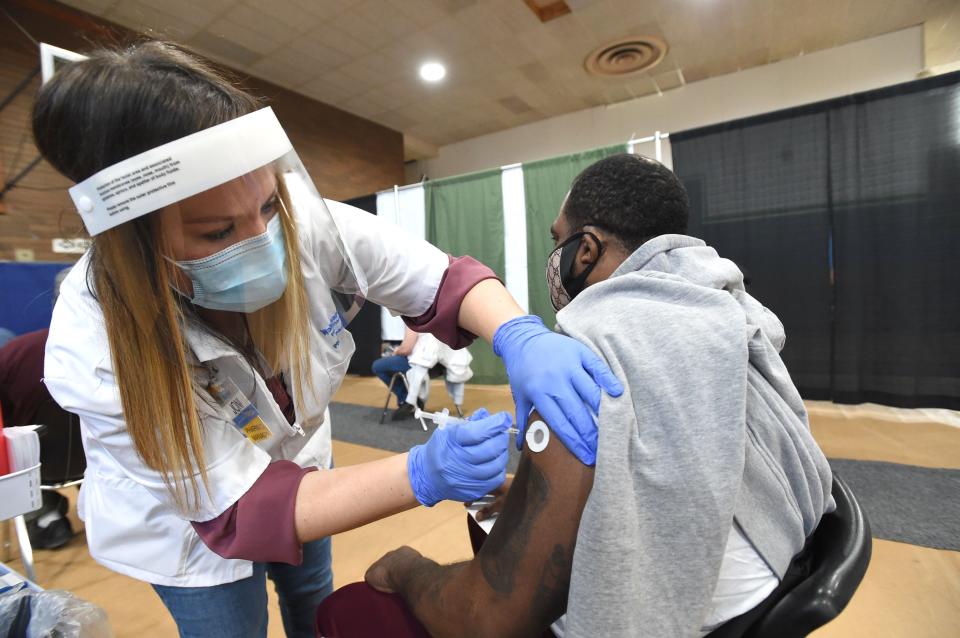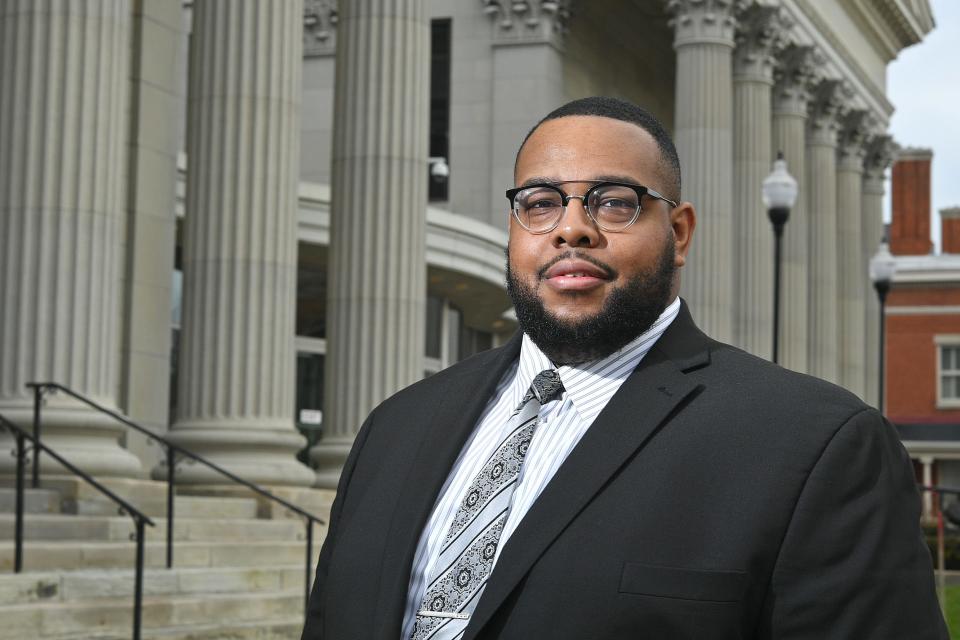How Erie County is addressing its other public health crisis: racism
- Oops!Something went wrong.Please try again later.
Fifteen months have passed since Erie County Council declared racism a public health crisis and officials say the resolution has been the catalyst to address disparities on several levels.
More: Erie County Council designates racism a public health crisis,
Consider this:
The county formed an internal diversity, equity and inclusion committee to look at issues of systemic racism in hiring practices, policies and other procedures. The committee is made up of county employees.
It also created a nine-member Diversity, Equity and Inclusion Commission and then seeded it an initial $3.5 million from Erie County's $52.3-million allocation of American Rescue Plan Act funding for 2021 and another $3.5 million for 2022.
The Erie County Health Department, UPMC Hamot, AHN Saint Vincent Hospital and the Lake Erie College of Osteopathic Medicine have made intentional efforts to provide COVID-19 testing and vaccinations at local community centers, like the Martin Luther King Jr. Center and Booker T. Washington Center, among other locations densely populated by racial minorities.
It used federal Coronavirus Aid, Relief and Economic Security Act funding to establish a micro-loan program through the Erie County Redevelopment Authority that provides low-interest loans to minority-owned businesses. Since then, it has received another $250,000 from the state and an additional $750,000 from the American Rescue Plan.
And the county recently hired Marcus Yuille as its diversity and inclusion officer to address a range of issues in county government and beyond.
More: 'A jumpstart': Minority-owned businesses in Erie County eligible for new loan program

"A lot has happened in such a condensed period of time," said Erie County Councilman Andre Horton, a Democrat who represents the 2nd District. "Things continue to move rather rapidly. More important to me locally is that we feel the declaration will be the impetus or foundational piece to address some of the other things that are systemically unfair to Black and brown communities."
Horton, who in 2013 became the first Black person elected to Erie County Council, was among those who were instrumental in pushing for the public health declaration, Resolution 43 of 2020. Even though he felt that changes made to the original version "watered down" its intent, he applauds his four other colleagues for passing it: Council members Carl Anderson, Mary Rennie, Ellen Schauerman and Kim Clear, who has since resigned after winning a Millcreek Township supervisor position in the November election.
Councilmen Brian Shank and Scott Rastetter voted no.
"If you go back to the summer of 2020, shortly after the George Floyd murder and so many others across the United States, there was a racial reckoning that came as a result of that," said Gerald Blanks, the chairman of the new Diversity, Equity and Inclusion Commission and head of the Greater Erie Economic Development Corp. "I think that resonates with this (resolution).
"The persistent negative effects of discrimination in America, if left unchecked, exacerbate the morally reprehensible deprivation of people of color," he said. "That's where we are. The (resolution) in and of itself was the right thing to put forth. And I think if done correctly, which we will do, we can really make some historic and systemic changes."
Officials, though, are realistic about how monumental the task at hand is.
"A number of things have been done that will hopefully help move the trajectory," outgoing Erie County Executive Kathy Dahlkemper said. "Obviously, there is going to be a long view on this. Something that has been generational for hundreds of years is not going be turned around overnight."
Why it's a crisis
The public health declaration aims to address a range of disparities, some of which were long known but brought to the fore by the COVID-19 pandemic and the killing of Floyd at the hands of Minneapolis police in May 2020.
More: 'Not just one person': Vigil held in Erie for George Floyd on 1-year anniversary of death
The resolution cited dozens of disparities in healthcare, education, housing and the economy facing people of color in Erie County. Here are some examples:
22% of Erie's Black population experiences food insecurity, compared to 9% of white residents.
68.2% of Black women received first trimester prenatal care compared to 82.9% of white women.
The percentage of low-birthweight babies born to Black mothers, 12.8%, is higher than those born to white babies, 7%.
The infant mortality rate for Black babies was 22.8 for every 1,000 live births compared to 4.9 for every 1,000 live births for white babies.
Black residents die from cancer and diabetes at a higher rate than white residents and suffer higher rates of heart disease, obesity, and COPD. Black residents also report mental health issues and being in poor physical health at higher rates.
Federal agencies financed half of all suburban homes in Erie County in the 1950s and 1960s, with 98% of loans going to white people.
Though people of color make up 16% of the population, they make up 37% of the occupancy of subsidized housing.
Persons of color represent 20% of all rental-unit occupancy in Erie County, but only 5% of homeownership.
The median income for white families is $62,235, compared to $28,814 for Black families. Nonfamily households of white residents had a median income of $28,349, compared to $16,585 for Black residents.
38.6% of Black residents live below the poverty line, compared to 14.1% of white residents.
More: In block after block of city neighborhoods in Erie, there's not a bank to be found
Horton added that minority communities were also disproportionately affected by the pandemic.
"Systemically, Black and brown communities are always marginalized on the bottom rung of the ladder, whether it's in health or employment, in financing or banking, or housing, public accommodations, transportation," he said. "The resolution itself was like: 'OK, anybody who has an ask and they feel that they've been (marginalized), this resolution can be pointed to, to say this is why we have to do this with intentionality.'"
Health equity
In the early stage of the pandemic, the county partnered with the Minority Community Investment Coalition, a collaboration of the city's community centers that focuses on economic development to improve outcomes for Erie’s most vulnerable populations, in order to address COVID-19, which has disproportionately affected communities of color.
"Those partnerships have continued on all the way to today," Dahlkemper said. "We're still doing testing on a weekly basis."
UPMC Hamot, Saint Vincent and LECOM have also held regular vaccine clinics at the community centers.
More: COVID-19 highlights Erie County race, class disparities
"We're starting to build trust in the community, which is something that really has been so detrimental, and rightfully so, in the past," Dahlkemper said. "The trust hasn't been there, but rebuilding that trust with the medical community is really key."
The county is providing funding for a community health worker for each community center. The position, which the county is funding for five years, will be critical for providing health care to underserved populations now and once the pandemic is over, Dahlkemper said.
"We thought this pandemic was an opportunity to try to change that partnership and to bring in a trusted person, somebody who they could identify with," she said. "And then that person will work directly with the (Erie County) Department of Health."
Diversity Loan Program
The Erie County Redevelopment Authority received $250,000 from the county to launch the micro-loan program earlier this year, then it got another $250,000 from the Enterprise Development Fund of Erie County — a separate entity, but managed by the ECDRA — via the Department of Community and Economic Development’s Pennsylvania Minority Business Development Authority.
This month, Dahlkemper announced plans to invest an additional $750,000 into the program from the county's $52.3-million share of American Rescue Plan funding.
It's a significant investment for a program that provides loans ranging from $5,000 to $35,000.
So far, 22 businesses or hopeful startups have applied for the loans. Ten have been awarded the funding, with most receiving about $25,000 each, said Tina Mengine, chief executive officer of ECRDA. Other applicants are awaiting approval or have been referred to the Erie Small Business Development Corp. or the business incubator Paramount Pursuits.
Mengine said the ECRDA is "learning a lot as we go." Some entrepreneurs and small business owners have either no credit or carry significant student-loan debt. Others lack a full business plan.
"That's why we're partnering with these other organizations to help them," she said. "We can give them a loan, but if they don't have a business plan ... we're not really helping them. So, the partnerships are critical. Erie's Black Wall Street, there's a number of different, small organizations throughout Erie that we're trying to partner with to make sure that we're doing the right thing by these organizations, not just handing out loans to say we handed out loans."
The money has allowed businesses to buy equipment or simply to establish credit so that they can qualify for loans through traditional banking.
"They don't traditionally have strong relationships with their banks," Mengine said. "Often we find a lot of the applicants don't have a business account. They're merging their personal and business accounts. And so there's an education process here. But that lack of capital puts them at a disadvantage."
Women, minorities and new Americans are eligible for the loans.
More: The ranks of Black-owned businesses in Erie are small but growing
Darrell Roberts, who started Triple D's Tastey Grill, 3512 Liberty St., after working for years as a food truck operator in downtown Erie, was one of the applicants. Roberts received a $16,500 loan in July to help with the operating costs of his new business.
Roberts, who previously worked as a teacher's assistant and coach for the Erie School District, used to rely on small loans from family and friends for his business ventures, instead of a bank.
"I think more minority businesses need to just have an inside track and just have the information to know where to go," he said.

Roberts is among a small population of Black-owned business owners. A 2020 survey by Erie Arts & Culture and Erie's Black Wall Street found that there were just 92 Black-owned businesses out of 5,000 countywide.
Roberts, 39, found out about the micro-loan program through the owner of Pineapple Eddie Southern Bistro.
"A lot of these things you don't even know about when it comes to grants or loans unless you know someone who's got the insights on the money that can help, you know what I mean?" Roberts said. "So I filled it (loan application) out because throughout this year, doing payroll and inventory and paying bills, it can get a little tough, especially doing it on your own."
Roberts said he's appreciative of the help.
"I'm just grateful for the opportunity to be able to even receive the loan from Redevelopment," he said. "I'm just hoping that in the near future we can have more things to come that can continue to help us grow."
More: Critical race theory isn't taught in NWPA schools, but controversy still looms
Someone to 'drive the changes'
Shortly after County Council declared racism a public health crisis, Dahlkemper's administration formed a diversity, equity and inclusion committee made up of county employees.
"But it was pretty apparent early on that we really needed someone, an employee, to be able to help guide that committee and to drive the changes that need to happen internally," she said.
That's where Marcus Yuille comes in.

Yuille, 29, worked 2½ years for the Erie County Library when then-Director Blane Dessy encouraged him to be part of a newly formed diversity, equity and inclusion committee.
Yuille agreed to volunteer, but when the position opened for diversity, equity and inclusion officer — someone with the full-time duty of putting into action the recommendations of the committee — he wasn't sure he had the qualifications.
Yuille, who has a bachelor's degree in political science and a master's degree in human resources, hesitated at first. But when the county called for applicants for the third time, he opted to submit his resume. He was hired two interviews later.
It was a reversal of fortunes of sorts. After receiving his bachelor's degree from Penn State Behrend, Yuille applied for jobs all over Erie, but settled for work in the dish room at a local IHOP because "I just needed a job."
"I'm no EDI specialist," he said. "I'm no subject-matter expert. I just had some lived experiences. It took me nearly four years and several different opportunities applied for to get a job at the county. So I know how tough it can be to get employment with Erie County."
Now, one of Yuille's primary focuses will be finding out why the county's workforce of 1,300 people has disproportionately fewer people of color compared to the county's overall population.
"We have to internally have a shift in culture and create what our message is and figure out why we aren't seeing people of color apply," he said. "Or when they do apply, why they're not being hired. And why, when they're hired, are they not staying? These are things that we need to really look at when we do work on recruitment and retention."
Especially concerning to Dahlkemper and Yuille is the lack of diversity among employees in management and supervisory positions.
Yuille hopes the changes the county is able to make internally can encourage private entities to follow suit.
The committee continues examining county policies and practices.
It's already addressed one area familiar to Yuille, Dahlkemper said.
"They actually looked at the collection and they said the collection doesn't reflect the community," she said. "So they've been making changes in the collection at the library, so it better reflects the Erie County community as a whole."
'Generational impact'
In September, Erie County Council took another step toward addressing the public health crisis, voting to form the Erie County Diversity, Equity and Inclusion Commission, an entity separate from the internal committee.
The commission, in accordance with the American Rescue Plan, will invest "in racially diverse populations by granting funding that creates opportunities for minority populations, lobbies for inclusive policy, and empowers minority populations throughout Erie County while adhering to the ARPA guidelines and policies."
County Council finished seating the nine board members at the end of September. On Oct. 20, the commission held its first meeting.
More: Here is how, and when, Erie County Council might create a 'diversity commission'
"It was created to address those households and businesses and populations that have been disproportionately impacted by COVID-19," Blanks, the chairman, said. "And a part of this is to invest and stimulate investment in historically disadvantaged populations and neighborhoods, to empower the minority community. That's the primary reason why we believe in this whole DEI commission and we're doing really good things to this point."
The commission wants to make a "generational impact," he said.
With the combined $7 million, the commission hopes to create what Blanks calls "pathways to family-sustaining employment" by getting people involved in the trades, boosting minority-owned businesses, and finding other avenues that will allow people to support a family.
But Blanks, Horton and Dahlkemper also expressed displeasure at some County Council members for not living up to their word. The commission, they said, was originally scheduled to receive $10 million.
"Imagine a third of your budget going away without any prior notification, no justification, nothing like that," Blanks said. "I found it ironic that Councilman Carl Anderson, who asserted that he started the DEI commission, was the swing vote who decided to take $3 million out of the budget."
Others who voted to reduce funding from $6.5 million to $3.5 million for 2022 were Republicans Ellen Schauerman, Scott Rastetter and Brian Shank.
Anderson, a Democrat, said he was in a "tough spot of doing either what appeared to be politically expedient and what is in the best long-term interests of the commission."
He addressed his decision at the Nov. 30 special meeting of Erie County Council.
"I was proud to be one of the people to stand up and put the idea of the Diversity, Equity and Inclusion Commission together and I have a great belief in its potential and great trust in the people that we have appointed to this particular board," he said. "However, with a new council and a new administration (in 2022), essentially what we're doing with this budget is earmarking funding for these particular programs. The funding can be changed or eliminated.
"My fear is there will be an attempt to eliminate the funding if we do not work in a similar fashion to what we did last year and mirror each of the ARPA funding cycles that we've had before," he continued. "Because I'm for this program and because I believe in their mission and because I believe that their success is going to go far beyond just the ARPA funding, I feel just the opposite of my colleague and perhaps some of the others that for the strength and survival of this particular program the funding needs to be reduced."
Anderson also said the real potential for funding for the commission will come from grants and philanthropic funding.

He noted that Erie County Council has taken other steps that positively affect minority communities, like granting a tuition waiver to attend the first year of the Erie County Community College, establishing a Day Reporting Center to reduce recidivism, and working with the Erie County Gaming Revenue Authority to establish a reimbursable grant program for minority groups.
Contact Matthew Rink at mrink@timesnews.com. Follow him on Twitter at @ETNrink.
This article originally appeared on Erie Times-News: Racism in Erie County: Addressing the county's other public health crisis

